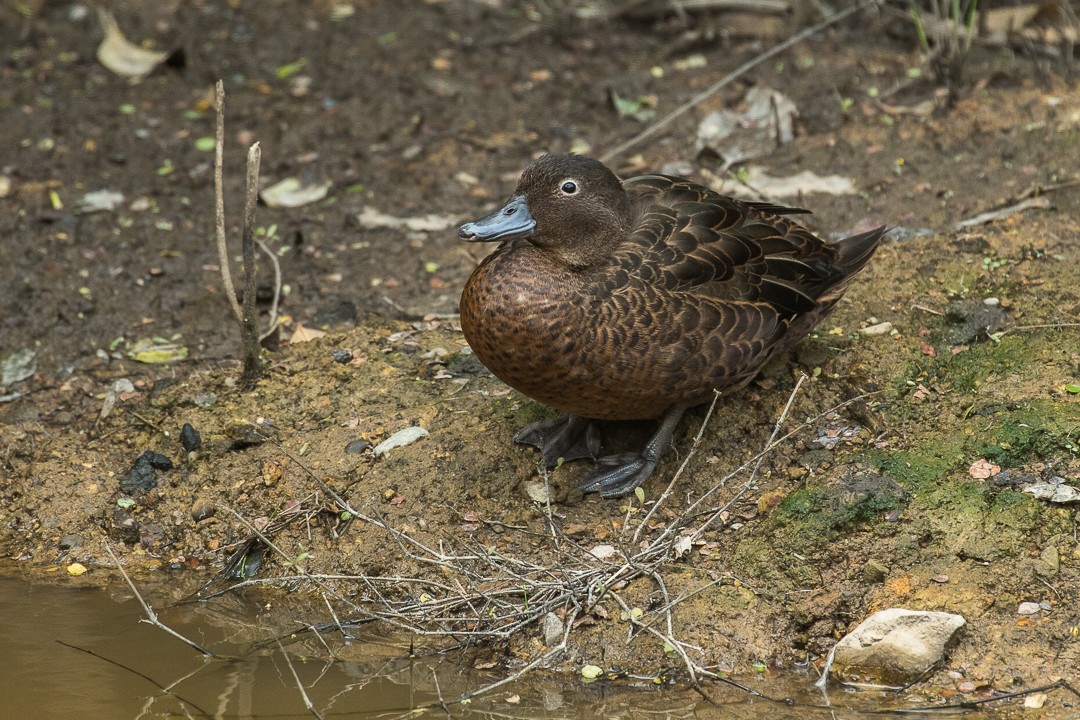Brown Teal
A species of Anas, Also known as Pateke Scientific name : Anas chlorotis Genus : Anas
Brown Teal, A species of Anas
Also known as:
Pateke
Botanical name: Anas chlorotis
Genus: Anas
Content
Description General Info
 Photo By Francesco Veronesi , used under CC-BY-SA-2.0 /Cropped and compressed from original
Photo By Francesco Veronesi , used under CC-BY-SA-2.0 /Cropped and compressed from original Description
There are no distinctive differences between a male, female and a juvenile brown teal during non-mating season. They all have a white ring around their eyes as well as a mottled brown color on their heads and throat. During breeding season the male will begin to change color, now having a green colored head, chestnut colored breast and a white stripe on each side of their body. They will sometimes also have a white clerical neck band. This does vary as some males do tend to be more colorful than others. 
Size
50 cm
Colors
Brown
Black
Green
Gray
White
Blue
Life Expectancy
21 years
Nest Placement
Ground
Feeding Habits
Brown Teal primarily consumes aquatic invertebrates, including insects, larvae, crustaceans, and mollusks. Unique to brown Teal is a jackhammer-like technique to extract flesh from cockles. They dabble and upend while foraging in water and also forage on land at night.
Habitat
Brown Teal primarily inhabit coastal freshwater wetlands and streams within agricultural landscapes, as well as sheltered coastal bays. They are also found in marshes, pools, and streams lined with trees. Historically, brown Teal occupied a broader range, including forested ecosystems, before the impact of human settlement led to a reduction and transformation of their natural habitats.
Dite type
Omnivorous
General Info
Feeding Habits
Bird food type
Behavior
The brown teal is largely nocturnal in habit by dabbling duck standards. This is an evolutionary response to natural diurnal predators such as the New Zealand falcon, Eyles' harrier, or skuas further south in their range. Brown teal have no defense against introduced cats, dogs, stoats & ferrets, which can kill adults & ducklings, or against rats which eat eggs. 
Distribution Area
This species is endangered and occurs predominantly on offshore islands but also in predator-proof sanctuaries on the mainland such as Tawharanui Regional Park. Formerly, it was widespread on the New Zealand mainland, but it disappeared there due to introduced predators like cats, dogs and rats, which easily preyed on this unwary, weakly flying bird. According to the IUCN categorization as VU D1, fewer than 1000 adult birds remain. The species has recently been upgraded to endangered by Birdlife International (Birdlife 2007), and the change will be reflected in the next update of the IUCN red list. 
Species Status
This species is endangered and occurs predominantly on offshore islands but also in predator-proof sanctuaries on the mainland such as Tawharanui Regional Park. Formerly, it was widespread on the New Zealand mainland, but it disappeared there due to introduced predators like cats, dogs and rats, which easily preyed on this unwary, weakly flying bird. According to the IUCN categorization as VU D1, fewer than 1000 adult birds remain. The species has recently been upgraded to endangered by Birdlife International (Birdlife 2007), and the change will be reflected in the next update of the IUCN red list. 